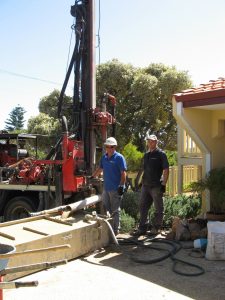Drilling a New Bore in Perth
 Water bores are drilled through sand, limestone or clay overlying the Perth Superficial Aquifer. The depth to the water table varies from suburb to suburb but usually the bore is drilled ten metres deeper than the water table depth.
Water bores are drilled through sand, limestone or clay overlying the Perth Superficial Aquifer. The depth to the water table varies from suburb to suburb but usually the bore is drilled ten metres deeper than the water table depth.
The Perth Groundwater Map is a Western Australian Government online-publication that allows residents to determine the depth to water beneath their property. Drillers use the Perth Groundwater Map when estimating the cost of drilling a bore. Deeper bores require more drilling, larger pumps and stronger screens.
Bores are drilled using the mud rotary drilling method. Mud is a mixture of water and clay that is pumped to the bottom of the hole through rotating, hollow drill-rods attached to a drill bit. Sand, clay or limestone drill cuttings are carried by the returning mud to a tank on the surface where they are removed and the mud re-circulated down the hole. After completion of the drilling, the bore is screened, cased, gravel packed and developed with an air compressor.
Compressed air is used to displace drilling mud from the hole and to encourage water from the aquifer to enter through the screen. In some instances chemicals are used to break down residual clay or other drilling muds that have resisted the initial development process and are preventing water from entering through the bore screen.
On a follow-up day, the bore is equipped with a submersible pump which is wired to the switchboard by a licensed electrical contractor. After the bore water supply is connected to the reticulation system, the reticulation controller is adjusted to suit a pump-based system and the bore is then ready for use by the customer. Bore owners in Perth are permitted to operate their bores on three days each week.
